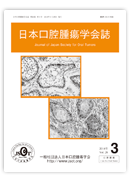Volume 26, Issue 3
Displaying 1-11 of 11 articles from this issue
- |<
- <
- 1
- >
- >|
The 32nd Annual Meeting of Japan Society for Oral Tumors
Symposium 2: “Key points for successful mandibular reconstruction”
-
2014Volume 26Issue 3 Pages 53
Published: September 15, 2014
Released on J-STAGE: October 01, 2014
Download PDF (191K) -
2014Volume 26Issue 3 Pages 54-56
Published: September 15, 2014
Released on J-STAGE: October 01, 2014
Download PDF (242K) -
2014Volume 26Issue 3 Pages 57-62
Published: September 15, 2014
Released on J-STAGE: October 01, 2014
Download PDF (756K) -
2014Volume 26Issue 3 Pages 63-68
Published: September 15, 2014
Released on J-STAGE: October 01, 2014
Download PDF (1111K) -
2014Volume 26Issue 3 Pages 69-77
Published: September 15, 2014
Released on J-STAGE: October 01, 2014
Download PDF (1151K) -
2014Volume 26Issue 3 Pages 78-88
Published: September 15, 2014
Released on J-STAGE: October 01, 2014
Download PDF (1867K) -
2014Volume 26Issue 3 Pages 89-94
Published: September 15, 2014
Released on J-STAGE: October 01, 2014
Download PDF (501K)
Original Articles
-
2014Volume 26Issue 3 Pages 95-102
Published: September 15, 2014
Released on J-STAGE: October 01, 2014
Download PDF (553K) -
2014Volume 26Issue 3 Pages 103-112
Published: September 15, 2014
Released on J-STAGE: October 01, 2014
Download PDF (483K)
Case Reports
-
2014Volume 26Issue 3 Pages 113-121
Published: September 15, 2014
Released on J-STAGE: October 01, 2014
Download PDF (1825K) -
2014Volume 26Issue 3 Pages 123-129
Published: September 15, 2014
Released on J-STAGE: October 01, 2014
Download PDF (1021K)
- |<
- <
- 1
- >
- >|
